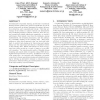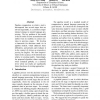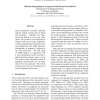501 search results - page 58 / 101 » Improving Language Models by Clustering Training Sentences |
KDD
2005
ACM
14 years 8 months ago
2005
ACM
Discriminative sequential learning models like Conditional Random Fields (CRFs) have achieved significant success in several areas such as natural language processing, information...
EMNLP
2010
13 years 6 months ago
2010
Almost all Chinese language processing tasks involve word segmentation of the language input as their first steps, thus robust and reliable segmentation techniques are always requ...
ACL
2006
13 years 9 months ago
2006
Pipeline computation, in which a task is decomposed into several stages that are solved sequentially, is a common computational strategy in natural language processing. The key pr...
BMCBI
2010
13 years 8 months ago
2010
Background: Sequencing of environmental DNA (often called metagenomics) has shown tremendous potential to uncover the vast number of unknown microbes that cannot be cultured and s...
NAACL
2007
13 years 9 months ago
2007
Letter-to-phoneme conversion generally requires aligned training data of letters and phonemes. Typically, the alignments are limited to one-to-one alignments. We present a novel t...



